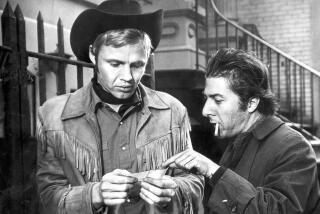Movies Make Patients’ Day, Some Therapists Find
- Share via
ERIE, Pa. — When psychiatrist Fuat Ulus meets with patients, there’s a chance that Clint Eastwood will be there too.
Not as a patient, but as a therapist of sorts.
Ulus has used Eastwood’s Dirty Harry character to help patients address chronic anxiety. After all, there probably aren’t many more anxious situations than when Inspector Harry Callahan is confronted with a thug holding a gun to a human shield and threatening to shoot.
Ulus doesn’t advise patients to deal with their anxiety by brandishing a .44-caliber Magnum and declaring, “Go ahead, make my day.” But watching the scene can spark discussion on coping with anxiety.
He has also used “The Deer Hunter” to help Vietnam veterans open up about post-traumatic stress disorder.
Ulus is among a handful of therapists who find movies or clips from movies helpful in treating patients.
“Patients are more receptive to discussing issues that are somewhat removed from them, played out by characters on a screen, rather than directly confronting those issues from their own lives,” Ulus said.
He recently wrote “Movie Therapy, Moving Therapy!”, a guide for therapists interested in using movies, and is developing a weekly movie therapy program that would be open to the public.
“Therapists have used movies for a long time, but in an informal way,” said Birgit Wolz, an Oakland therapist who’s been using movies in group therapy sessions for nearly a decade.
In movie therapy, therapists won’t simply advise depressed patients to rent, say, “It’s a Wonderful Life.”
“A good comedy is always nice when I don’t feel good, but it’s not going to have much therapeutic value,” Ulus said.
The assumption that movies can be prescribed to treat a problem can backfire, Wolz said. “If you’re renting a happy movie when you’re sad, it can have the opposite effect” and make a sad person more depressed, she said.
Instead, therapists might use a movie or segment that illustrates a situation that a patient is experiencing -- whether the patient realizes it or not. The patient might find it easier to confront his own issue after seeing how someone in a movie handles a similar situation.
“The movies really go to the deeper layers of the consciousness,” Wolz said. “The movies are a catalyst for the experiences people go through.”
John W. Hesley, a Dallas-Fort Worth area therapist who along with his wife, Jan G. Hesley, wrote the 1998 book, “Rent Two Films and Let’s Talk in the Morning: Using Popular Movies in Psychotherapy,” has a theory on why a problem that seems overwhelming might be less burdensome after movie therapy.
“You can talk about it sometimes easier if it’s happening to someone else,” he said.
Ulus and Wolz say movie therapy is gaining in popularity, but no one has concrete numbers on its use. A couple dozen people participate in Ulus’ Internet movie therapy mailing list.
Pam Willenz, spokeswoman with the American Psychological Assn., said the association doesn’t take positions on treatment types, but recognizes film’s use in therapy. The organization also doesn’t track practitioners.
Therapists stress that movie therapy isn’t a treatment in itself. Rather, they say, it’s a tool that can be used with other treatments in individual and group settings.
Movies “are metaphors that have emotional truths for people,” said Bernie Wooder, a London psychotherapist who’s used movies for about seven years.
The melding of movies and therapy was natural for Ulus, 60, a self-described movie buff who estimates that he’s seen thousands of films. He immigrated to America in 1971 from Turkey, where he said his mother would take him to see several movies a week when he was growing up in the 1950s and 1960s, and they helped him learn American culture.
Now, in a given month, he might see 50 or 60 movies, some theater releases and other movies that he’s already seen, but from which he hopes to glean a lesson.
Although movie therapy may not be widely known, its roots can be traced to bibliotherapy, which uses books in much the same way and was developed in the early part of the 1900s.
“I think movie therapy is a little more colorful and fascinating than bibliotherapy,” Ulus said.
There’s another benefit too.
“It’s a whole lot easier to have a patient watch a movie than to read a book,” John Hesley said.


